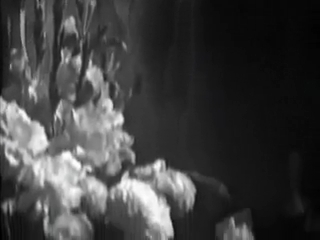The BBC’s
great television production broadcast live in December, 1954, is said to have brought
great consternation to Britain, Tories in the Commons promoted a censure of
unseemly material for a Sunday evening, the royal household spoke of its
pleasure notwithstanding, a second live performance that same month went on as
scheduled, and was recorded.
The reason for so
much upset is plain to see but harder to define. Neither the electrical
violence of the torture scene nor the synthetic smut offered to the proles is
rare in its dramatic usage, rather the style is an application generally of a device
that can be observed directly in Hitchcock’s Foreign Correspondent
as Herbert Marshall’s pirouette from mainstay to menace. Nigel Kneale and
Cartier prepare this so slowly and with such a patient Englishness that the
effect is particularly excoriating. There is a certain relationship to
Welles’ American broadcast of Wells.
Quatermass II
Cartier’s
live television production with ample film sequences depicts an invasion of
Earth by aliens from a gaseous planet, possibly “a moon of Saturn”.
It’s built from
the failure of Prof. Quatermass to achieve his moon base, owing to a
catastrophic explosion of the nuclear motor during a ground test of Quatermass
II in Australia.
A rival project
now has Ministry support for the manufacture of synthetic food at a secret
installation rapidly built on the site of a small town, Winnerton Flats, and
oddly it resembles his own plans for the moon.
The ammonids land
in meteor showers and occupy human bodies. They assemble a work force, the
plant is built, “it looks like a refinery”.
Orders from very
high up forbid the launch of Quatermass II against a false asteroid that
is the launch base of the invasion. Quatermass proceeds, a sort of unitary bond
among the “zombies” all over the world is broken (top secret files
reveal the existence of earth bases everywhere).
Kneale’s
teleplay obtains the maximum of force by dint of total mobilization à la
Henry V, and a general sense of weirdness leading by very small degrees
of cogent understanding to a stark, clear view ably expressed.
Quatermass and the Pit
It can’t
happen here, but it happened in Germany, Nigel Kneale wrote it all out, Cartier
directed it for the BBC.
The pit or
excavation directly prefigures the Tycho Magnetic Anomaly in 2001: A Space
Odyssey, and of course Professor Quatermass is here for the space angle.
The rest is all
Kneale and Mein Kampf on a construction site in Hobbs Lane, London.
An excellent joke
on “Knightsbridge apemen” is one of the many small details in one
of the most magnificent productions ever realized with live cameras.
Anna Karenina

Almost nothing
discursive in the direction, the train station in Moscow, a slow tilt-and-pan
from the lovers sequestered in a gypsy restaurant (where the music is like
singing birds) to the long brass curtain rod and a bouquet of flowers and back
to the lovers, otherwise an extraordinary straightforward reading that takes
into account Duvivier from the start and slowly builds up details in the course
of its feature length to give an exact, fulsome rendering.
An English
adaptation of a French play by one of the screenwriters who labored on De Mayerling à Sarajevo (dir. Max
Ophuls). Claire Bloom, Albert Lieven, Sean Connery
(cutting a dash like Douglas Fairbanks, Jr. at first, then shaping the role
effectively as a Clark Gable study), et
al.
The News-Benders
CWNS, the
Classified World News Service, runs the world since 1945 with phony news
stories.
A sometime BBC
director is required to work for them or die.
Donald Pleasence,
Nigel Davenport.